Mid-Continent Railway Museum
The Mid-Continent Railway Museum is a railroad museum in North Freedom, Wisconsin, United States. The museum consists of static displays as well as a 7-mile (11 km) round trip ride aboard preserved railroad cars.
| Mid-Continent Railway Museum | ||||||||||||||||||||||||||||||||||||||||||||||||||||||||
|---|---|---|---|---|---|---|---|---|---|---|---|---|---|---|---|---|---|---|---|---|---|---|---|---|---|---|---|---|---|---|---|---|---|---|---|---|---|---|---|---|---|---|---|---|---|---|---|---|---|---|---|---|---|---|---|---|
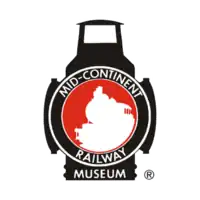 | ||||||||||||||||||||||||||||||||||||||||||||||||||||||||
 The restored 1894 Chicago and North Western depot serves as the starting point for museum visitors | ||||||||||||||||||||||||||||||||||||||||||||||||||||||||
| Locale | E8948 Museum Road, North Freedom, Sauk County, Wisconsin | |||||||||||||||||||||||||||||||||||||||||||||||||||||||
| Coordinates | 43.46°N 89.87°W | |||||||||||||||||||||||||||||||||||||||||||||||||||||||
 Route map of the Mid-Continent Railway Museum | ||||||||||||||||||||||||||||||||||||||||||||||||||||||||
| Connections | Wisconsin and Southern Railroad | |||||||||||||||||||||||||||||||||||||||||||||||||||||||
| Commercial operations | ||||||||||||||||||||||||||||||||||||||||||||||||||||||||
| Built by | Chicago and North Western Transportation Company | |||||||||||||||||||||||||||||||||||||||||||||||||||||||
| Original gauge | 4 ft 8+1⁄2 in (1,435 mm) standard gauge | |||||||||||||||||||||||||||||||||||||||||||||||||||||||
| Preserved operations | ||||||||||||||||||||||||||||||||||||||||||||||||||||||||
| Reporting mark | MCRY | |||||||||||||||||||||||||||||||||||||||||||||||||||||||
| Stations | 1 | |||||||||||||||||||||||||||||||||||||||||||||||||||||||
| Length | 3.7 miles (6.0 km) | |||||||||||||||||||||||||||||||||||||||||||||||||||||||
| Preserved gauge | 4 ft 8+1⁄2 in (1,435 mm) standard gauge | |||||||||||||||||||||||||||||||||||||||||||||||||||||||
| Commercial history | ||||||||||||||||||||||||||||||||||||||||||||||||||||||||
| Opened | 1959 | |||||||||||||||||||||||||||||||||||||||||||||||||||||||
| Closed | 2008–2009 | |||||||||||||||||||||||||||||||||||||||||||||||||||||||
| Preservation history | ||||||||||||||||||||||||||||||||||||||||||||||||||||||||
| 1959 | Railroad Historical Society of Milwaukee formed and first steam locomotive acquired | |||||||||||||||||||||||||||||||||||||||||||||||||||||||
| 1962 | Train rides first operated on the Hillsboro and Northeastern Railway and North Freedom branchline purchased | |||||||||||||||||||||||||||||||||||||||||||||||||||||||
| 1963 | Equipment moved to new location and trains first operated | |||||||||||||||||||||||||||||||||||||||||||||||||||||||
| 1965 | Depot moved from previous location | |||||||||||||||||||||||||||||||||||||||||||||||||||||||
| Headquarters | North Freedom, Wisconsin | |||||||||||||||||||||||||||||||||||||||||||||||||||||||
| Website | ||||||||||||||||||||||||||||||||||||||||||||||||||||||||
| midcontinent | ||||||||||||||||||||||||||||||||||||||||||||||||||||||||
| ||||||||||||||||||||||||||||||||||||||||||||||||||||||||
History
The rail line used by the Mid-Continent Railway Museum is a spur off the original Chicago and North Western Railway mainline. With the development of the Illinois Iron mine in early 1903, the C&NW sent a team of engineers on July 8, 1903, to survey a route to the iron fields. By August 12, C&NW president Marvin Hughitt had arrived in North Freedom in person to announce that a branchline would be built. A second major mine, the Iroquois Mine (also called the Sauk Mine), was established in October not far from the new rail line. By December 1903, the 3-mile (4.8 km) branchline was completed at a cost of $40,533.
To support the increasing number of miners in the area, a new town called La Rue was platted, named after William G. La Rue. William La Rue was an area mining pioneer who demonstrated that the latest technological advancements in diamond drill technology could make iron mining in the area economically feasible. The town was surveyed and registered in January 1903, but it was soon realized that its location in the southwest corner of the intersection of present-day Highway W and Diamond Hill Road would prove to be too far from where the mines were developing. By November 1903, the development of the town shifted nearer to the Illinois Mine, 0.5 miles (0.80 km) to the south at the present day location of La Rue. At the height of iron mining production, the population of La Rue likely did not exceed 50 people, but the town did include a hotel, lumberyard, church, general store, and two saloons to supply and entertain the several hundred miners living nearby. Another townsite named Oliver was platted just east of La Rue, slightly closer to the Oliver Mining Company-owned Iroquois Mine, but no construction ever occurred.
At its peak, the Illinois Mine was shipping between five and 12 train car loads daily over the C&NW branchline, but La Rue's ironing mining days would be numbered. By June 1904, the mines were reaching depths of 400 to 500 feet (120 to 150 m) at which water infiltrating into the mine shafts began being problematic. Costs continued to grow as a result of the water infiltration until finally the Illinois Mine closed in 1908. By this time it was burdened by costs associated with pumping out 2,600 US gallons (9,800 L) of water per minute. A similar fate befell the Iroquois Mine in 1914, at which time it was pumping 4,500 US gallons (17,000 L) per minute from its mine shaft. With the end of iron mining operations, the town of La Rue quickly disappeared. By 1925, only one building remained: the La Rue tavern, which still stands today.
As the La Rue area iron mining days were ending, the need for quartzite rock was increasing. In 1917, Harbison-Walker Refractories Company established a quarry south of La Rue. The railroad track was extended 0.8 miles (1.3 km) south to serve the quarry. Operations continued until 1962 when the quarry ceased operation. The rail line was slated for abandonment soon after.[1]
Meanwhile, in 1959, a group of rail enthusiasts from the Milwaukee area had joined to form the Railroad Historical Society of Milwaukee. With the group's first acquisition of the Consumers Company #701 steam locomotive, the search for a home for their collection began. An agreement was reached with the Hillsboro and Northeastern Railway to operate diesel-powered train rides over their line beginning in 1962 under the name Mid-Continent Railway Museum. When it was learned the North Freedom branchline was available in 1962, the line was quickly purchased and the small collection of cars and locomotives were moved to North Freedom in 1963. By the summer of 1963, the move was finished and repairs to steam locomotive CNW 1385 were completed, allowing steam train rides to be offered for the first time that summer.[2] Train rides have been offered out of North Freedom by the museum every year since and a small rail yard was gradually built to hold the growing collection of preserved rail equipment.
In 2023, the museum hosted a 60th anniversary celebration event on May 27th, marking 60 years to the day that the first train pulled passengers along the 7-mile route.
Flooding and reopening
In June 2008, the museum grounds were inundated by floodwaters of the Baraboo River. The museum closed for repairs until February 2009.[3] The bridge's out-of-service status did not affect the route used by the museum's train rides, but did prevent the movement of rail cars and locomotives to and from the museum via the national rail network. Repairs to the bridge were completed in July 2018.[4]
Operations
Heritage railroad
The museum operates a heritage railroad which offers passenger excursion trains on a 7-mile (11 km) round trip. Trains leave from North Freedom, pass through the former mining community of La Rue, and turn around at a rock quarry, returning on the same route. The excursions take approximately one hour and operate daily from early June through Labor Day and most weekends in May, September, and October. Trains operate at a top speed of 15 miles per hour (24 km/h), requiring approximately 20 minutes to travel the length of the rail line. Roughly 15 minutes are spent at the end of the line to move the locomotive to the opposite end of the train for the return trip to North Freedom. During the ride, a uniformed conductor punches passengers' tickets, shares railroad history, and answers questions.
Special event trains are also offered several times throughout the year, including Autumn Color weekends in the fall, Pumpkin Special runs near Halloween, Santa Express Weekends at the end of November, and the Snow Train in February. During special events, additional ride options are frequently offered such as first class trains, dinner trains, and brunch trains which offer onboard food and beverage service and utilize cars which are more luxurious than the train cars typically used.
For most of the museum's history, nearly all trains were pulled by steam locomotives although since February 2000, all trains have been pulled by diesel-electric locomotives pending the restoration or repair of the museum's steam locomotives.
Collection
The Mid-Continent Railway Museum's collection emphasizes the preservation of railroad items operated in the upper Midwest from the period of 1880–1916, what the organization refers to as the "Golden Age of Railroading".[5] During that time, railroads saw an unprecedented rate of expansion, growing in size in the United States from 93,000 to 254,037 miles (149,669 to 408,833 km) of track.[6]
Two steam locomotives, Chicago and North Western 1385 and Western Coal and Coke 1, are being restored to federal guidelines. The museum's collection consists of nine steam locomotives, eight diesel locomotives, and over 100 other pieces of rolling stock. The museum has the largest collection of wooden passenger cars in the United States as well as five of only six surviving wooden boxcars built by the Mather Stock Car Company[7] and the nation's last surviving fish car, Wisconsin Fish Commission "Badger Car No. 2".[8] In 2015, the Museum decided to rationalize their collection by deaccessioning some of their equipment, including most of their disassembled locomotives.
The depot is an original Chicago and North Western Railway depot from the small town of Ableman, later Rock Springs, Wisconsin. It was built in 1894 and moved to the museum location in 1965. The depot consists of two seating areas separated by the ticket office, and a gift shop occupies the former freight room. The interior was extensively renovated following water damage during flooding in June 2008.
In addition to the depot, other railroad structures moved to the museum's location include a crossing shanty, crossing tower, section shed, and water tower. Additional structures have been built new to house and maintain the collection but attempts were made to make the structures appear period appropriate.
Locomotive roster
| Locomotive | Image | Manufacturer | Type | Build date | Status | Museum acquire date | Previous owner | Notes |
|---|---|---|---|---|---|---|---|---|
| Chicago and North Western 1385 | 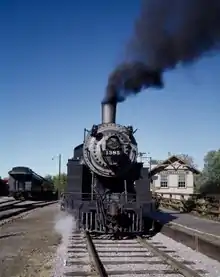 |
American Locomotive Company | R-1 4-6-0 steam locomotive | March 1907 | Undergoing operational restoration | 1961 | Chicago and North Western Transportation Company | One of the first locomotives the museum owned, used from 1963 to 1998. |
| Consumers Company 701 | American Locomotive Company | 0-4-0 steam locomotive | 1914 | Awaiting cosmetic restoration | 1959 | Consumers Company | This was the very first locomotive the museum owned. | |
| Dardanelle and Russellville 9 | Baldwin Locomotive Works | 2-6-0 steam locomotive | 1884 | Undergoing cosmetic restoration | 1963 | Dardanelle and Russellville Railroad | Operated on the museum's trackage in the late 1960s and early 1970s, and briefly returned to steam in 1991. | |
| Western Coal and Coke 1 | Montreal Locomotive Works | 4-6-0 steam locomotive | September 1913 | Awaiting operational restoration | 1965 | Lethbridge Collieries Limited | The only Canadian-built locomotive in the museum. Operated on the museum's trackage from 1970 to 1994. | |
| Kewaunee, Green Bay and Western 49 | _%2526_tender_2_(19305396752).jpg.webp) |
American Locomotive Company | 2-8-0 steam locomotive | March 1929 | Static display | 1981 | City of Wisconsin Rapids, Wisconsin | The only preserved locomotive from the Kewaunee, Green Bay and Western Railroad. Underwent cosmetic restoration in 2004. |
| Lake Superior and Ishpeming 22 | American Locomotive Company | SC-4 2-8-0 steam locomotive | January 1910 | Static display | 1985 | Marquette and Huron Mountain Railroad | Underwent cosmetic restoration, completed in 2016.[9] | |
| Minneapolis, St. Paul and Sault Ste. Marie 2645 | _5_(19318807661).jpg.webp) |
Brooks Locomotive Works | E-25 4-6-0 steam locomotive | November 1900 | Static display | 1988 | City of Waukesha, Wisconsin | Cosmetic restoration in 2004 during the Soo Line Historical & Technical Historical Society's annual convention. |
| Goodman Lumber Company 9 | _1_(18691517414).jpg.webp) |
Lima Locomotive Works | Shay steam locomotive | 1909 | Static display | 1988 | Historyland Museum | The only Shay locomotive in the museum. |
| Copper Range 29 | _%2526_tender_1_(19313844286).jpg.webp) |
American Locomotive Company | C2 2-8-0 steam locomotive | February 1907 | Static display | 2003 | Trans-Northern | The only Copper Range locomotive left to be preserved.[10] |
| Wisconsin Sand and Gravel 2 | Plymouth Locomotive Works | HL-18 diesel locomotive | 1928 | Operational | 1963 | Wisconsin Sand and Gravel Company | Occasionally used by the museum to move passenger cars in and out of the car shop. | |
| Montana Western 31 | Electro-Motive Corporation | Gas-electric car | October 1925 | Awaiting operational restoration | 1965 | Montana Western Railway | The oldest surviving, and largely unmodified gas-electric car built by the Electro-Motive Corporation. | |
| United States Army 4 | _2_(19123230928).jpg.webp) |
General Electric | 45-ton switcherdiesel locomotive | 1943 | Operational | 1972 | Pullman Company | Mainly used to pull locomotives in and out of the locomotive shop.[11] |
| Milwaukee Road 988 | _(19343992321).jpg.webp) |
American Locomotive Company | RSC-2 diesel locomotive | 1947 | Static display | 1985 | Trans-Northern Incorporated | |
| Wisconsin Power and Light 3 | Plymouth Locomotive Works | 30-ton switcher diesel locomotive | 1952 | Operational | 1987 | Wisconsin Power and Light Company | On loan to the Circus World Museum in Baraboo. | |
| John Morrell and Company 7 | 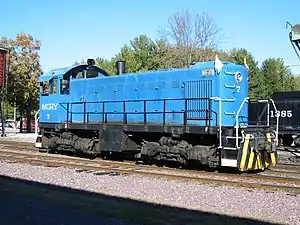 |
American Locomotive Company | S-1 diesel locomotive | 1944 | Operational | 1996 | Association of American Railroads | |
| United States Army 1256 | _2_(19122899820).jpg.webp) |
Baldwin Locomotive Works | RS-4-TC diesel locomotive | 1954 | Operational | 2006 | United States Army | Sold at an auction and donated by the winning bidders to the museum. |
| Arkansas, Louisiana and Missouri 10 | Electro-Motive Diesel | NW2 diesel locomotive | 1949 | Operational | 2018 | Domtar | Known as Domtar 1001.[12] |
Former locomotive roster
| Locomotive[13] | Image | Manufacturer | Type | Build date | Status | Time on the museum | Owner | Notes |
|---|---|---|---|---|---|---|---|---|
| Louisiana Cypress 2 | Lima Locomotive Works | 2-6-0 steam locomotive | 1906 | Awaiting restoration | 1960-2015 | Private owner | Formerly used by the museum to pull tourist trains from 1964 to 1971. | |
| Milwaukee Road 30 | Dodge | Sedan inspection car | 1947 | Display | 1961-2014 | Illinois Railway Museum | [14] | |
| Central Illinois Public Service Company 5 | H.K. Porter, Inc. | 2-4-2 steam locomotive | 1945 | Awaiting restoration | 1963-1971 | St. Louis, Iron Mountain and Southern Railway | Built as a tank locomotive, converted to a tender locomotive by the Crab Orchard and Egyptian Railway.[15] | |
| New York Central 6721 | American Locomotive Company | B-11k 0-6-0 steam locomotive | 1913 | Static display | 1963-1980 | Utica and Mohawk Valley Chapter of the National Railway Historical Society | Badly damaged after being hit by a hopper car at the Boehlert Transportation Center in 2015. Awaiting cosmetic restoration.[16] | |
| Alabama, Tennessee and Northern 401 | Baldwin Locomotive Works | SC-1 2-10-0 steam locomotive | 1928 | Static display | 1964-2015 | Age of Steam Roundhouse | Painted as Woodward Iron 41 during its time in North Freedom.[17] | |
| McCloud Railway 9 | 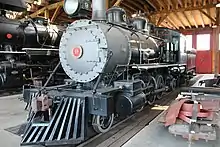 |
Baldwin Locomotive Works | 2-6-2 steam locomotive | 1901 | Static display | 1964-1971 | Age of Steam Roundhouse | Used by the museum to pull tourist trains until sold to the Kettle Moraine Railroad.[18] |
| Warren and Ouachita Valley 1 | Baldwin Locomotive Works | 4-6-0 steam locomotive | 1906 | Static display | 1965-1985 | Private owner | Formerly used by the museum to pull tourist trains. Repainted as Black River and Northern 1 in Black River, Wisconsin.[19] | |
| Central Illinois Public Service Company 6 | Vulcan Iron Works | 0-4-0 steam locomotive | 1923 | Awaiting restoration | 1965-2019 | Private owner | Used by the museum to pull tourist trains until 1970. | |
| Chicago, Burlington and Quincy 4960 | 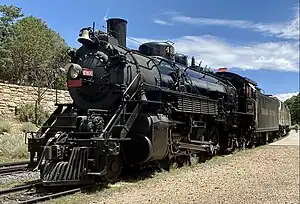 |
Baldwin Locomotive Works | O-1a 2-8-2 steam locomotive | 1923 | Operational | 1970-1989 | Grand Canyon Railway | Largest and heaviest locomotive the museum ever owned.[20] |
| Union Pacific 440 | 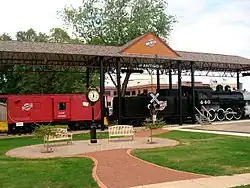 |
Baldwin Locomotive Works | C-57 2-8-0 steam locomotive | 1900 | Static display | 1975-2003 | Langlede County Historical Society | Painted in Chicago and North Western colors with the same road number.[21] |
| Saginaw Timber Company 2 | 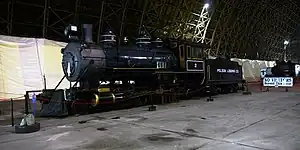 |
Baldwin Locomotive Works | 2-8-2 steam locomotive | 1912 | Operational | 1982-2017 | Oregon Coast Scenic Railroad | Used to pull the museum's tourist trains in association with a private owner, until ownership disputes moved it to Oregon in 2017.[22] |
| Lake Superior and Ishpeming 29 | .jpg.webp) |
American Locomotive Company | SC-3 2-8-0 steam locomotive | 1906 | Undergoing overhaul | 1985-1989 | Grand Canyon Railway |
Gallery
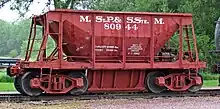 Minneapolis, St. Paul and Sault Ste. Marie 80944, an ore car built in 1916
Minneapolis, St. Paul and Sault Ste. Marie 80944, an ore car built in 1916
 Chicago and North Western 7409, a coach-baggage combine car
Chicago and North Western 7409, a coach-baggage combine car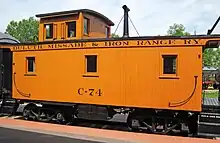 Duluth, Missabe and Iron Range C-74, a caboose built in 1924
Duluth, Missabe and Iron Range C-74, a caboose built in 1924
References
- Mid-Continent Railway Gazette (Vol. 36, No. 4). Mid-Continent Railway Historical Society, Inc. 2003.
- "A Mid-Continent Timeline". Mid-Continent Railway Historical Society. Retrieved January 29, 2018.
- "A Wisconsin Tradition Survives and Thrives". 27 January 2009. Archived from the original on 8 August 2014. Retrieved 13 July 2012.
- Bromley, Ben (July 8, 2018). "Mid-Continent reopens river bridge". Baraboo News-Republic. Archived from the original on August 22, 2018. Retrieved August 22, 2018.
- "About Us". Mid-Continent Railway Historical Society. Retrieved January 29, 2018.
- Mid-Continent Compendium. Mid-Continent Railway Historical Society, Inc. 2005. p. 11.
- "Mid-Continent Railway Museum Equipment Roster: Akron Canton & Youngstown #3011". Retrieved January 29, 2018.
- Tour of the Yards (fourth ed.). Mid-Continent Railway Historical Society, Inc. 2012.
- "Lake Superior & Ishpeming #22 – Mid-Continent Railway Museum". Retrieved 2021-12-31.
- "Copper Range #29 – Mid-Continent Railway Museum". Retrieved 2021-12-31.
- "Diesel/Other Locomotives – Mid-Continent Railway Museum". Retrieved 2021-07-24.
- "Domtar #1001 – Mid-Continent Railway Museum". Retrieved 2021-12-31.
- "Former Collection Items – Mid-Continent Railway Museum". Retrieved 2021-07-24.
- "Chicago Milwaukee St. Paul & Pacific #30 – Mid-Continent Railway Museum". Retrieved 2021-12-31.
- "Mid-Continent Railway Museum". donsdepot.donrossgroup.net. Retrieved 2021-10-11.
- "Pictures of NYC 6721". www.rrpicturearchives.net. Retrieved 2022-01-22.
- "Alabama, Tennessee & Northern 2-10-0 No. 401 – Age of Steam Roundhouse". Retrieved 2021-12-31.
- "McCloud River 2-6-2 No. 9 – Age of Steam Roundhouse". Retrieved 2021-05-23.
- "Warren & Ouachita Valley #1 - www.rgusrail.com". www.rgusrail.com. Retrieved 2021-10-11.
- "Mid-Continent Railway Museum". condrenrails.com. Retrieved 2021-12-31.
- "CNW #440 - www.rgusrail.com". www.rgusrail.com. Retrieved 2022-01-02.
- "Locked and loaded: Polson Logging No. 2 heads west this week | Trains Magazine". Trains. Retrieved 2021-11-04.